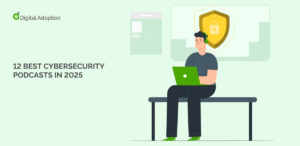The CIO’s role has changed significantly over the years, often bouncing back and forth between the role of a technology manager and a digital strategist. In this post, we’ll learn about the history of the CIO role, then see why CIOs will become the transformative leaders in tomorrow’s business world.
In this post, we’ll explore why the role of the CIO has changed, how it will continue to evolve, and what CIOs can do to prepare for the future.
A Brief History of the CIO Role
As technology entered the workplace, organizations needed to hire people with technical skills to manage their operations. Below, we’ll see how this technology leadership position has shifted over the years.
Before the 1980s, “information managers” ran IT departments.
Prior to the last two decades of the century, innovation was the domain of large companies, such as IBM.
For that reason, chief IT officers, or “information managers,” were typically tasked with procurement and on-site IT management.
It wasn’t until later that companies began to innovate with IT – and, as a consequence, CIOs began to work closely with other business leaders on strategic initiatives, digital innovation, and digital transformation.
The term “CIO” caught on in the 1980s.
In a book on information resource management, William R Synnott and his co-author first coined the term “chief information officer.”
This role was needed, they claimed, to counter the increasing complexity that was resulting from technology.
They envisioned the CIO as being an equal partner with other major executives, such as the CEO and CFO.
Importantly, they viewed CIOs not only as technologists, but as strategists.
Over time, some CIOs became IT operations managers, while others remained strategists.
Many companies recognized the strategic importance of IT, both as a performance booster and a competitive differentiator. In these organizations, CIOs maintained a high level of responsibility.
Other companies, however, relegated the CIO to the same role that they’d had prior to the 1980s – namely, they acted mostly as operations managers. In these organizations, IT was viewed more as a back-office function than as a driver of business value.
As digital transformation gradually transformed the business world, however, this began to change.
Today, the CIO role is returning to its roots as a strategic partner.
Digital transformation hasn’t slowed in recent years – disruptive innovation and the pace of change have actually accelerated.
CIOs, as a consequence, are being called upon to lead technology-driven innovation, spearhead digital transformation, and head up organizational change initiatives.
In fact, many CIOs already self-identify not just as strategic leaders, but also as transformational CIOs, according to sources such as IDG.
The Future of the CIO Role
What does the future hold for the CIO?
Here are a few trends to expect in the coming months and years:
The CIO is increasingly becoming a “business leader.” The CIO role is becoming more strategic, more business-oriented, and less focused on IT services management (ITSM), according to research from Gartner. Among other things, this transition implies that the CIO will need a subset of business skills on top of their IT skills.
The CIO will be responsible for driving digital transformation in the organization. All business leaders need to be digitally savvy, but the CIO, as the head of IT, is at the center of digital transformation. It’s their job to help their business identify and use technology to become more efficient, more effective, and more competitive in the digital economy.
The CIO will need to collaborate more closely with other business leaders. The CIO, for instance, will need to work with the CEO to make sure that the CIO’s vision aligns with the CEO’s and the company’s. They will also need to collaborate more closely with other line-of-business leaders and department heads.
They will need to understand the importance of emerging technology and digital transformation. Today’s emerging technology will drive tomorrow’s economy and company’s that adopt it early will become leaders in the digital age. CIOs, as the change leaders in the organization, will need to be the ones leading these innovative efforts.
CIOs have to be both tech savvy and business savvy to remain competitive in the modern organization. Technical know-how is sufficient for IT operations managers, but not for strategic business leaders or transformational leaders. To stay relevant, CIOs will need to adapt to their emerging role, proactively embrace their new responsibilities, and learn the right skills to stay successful.
CIOs will need to be able to make complex decisions in a very short timeframe. As CIOs become more strategic leaders, they’ll have to be able to make decisions more quickly than ever before. The new CIO will need to be able to make big decisions in a short timeframe, so they’ll need to be able to gather the right information and digest it quickly in order to make the right choice.To sum up: in the coming years, the CIO will no longer be the “IT person” who sits in the corner and provides infrastructure and support to the business. Instead, the CIO will need to sit at the table alongside the C-suite as a member of the business leadership team.
The Changing Role of CIOs in 2021 and Beyond
Analysts and research firms have widely recognized that the CIO’s role is rapidly changing.
According to IDG’s 2020 State of the CIO Report, for instance:
- 95% of CIOs said that their role was expanding beyond traditional IT responsibilities
- 39% of CIOs reported that their top priority was leading digital transformation initiatives
- 31% claimed that boosting corporate resiliency through IT and data security was a top priority
- 29% prioritized the collaboration of IT and business collaboration skills
- Strategic tasks became a top activity in 2020, increasing from 4% to 25%
In short, CIOs are transitioning from traditional IT service delivery to a more strategic role.
This same survey found that most CIOs are spending more time on aligning IT projects with business goals (44%), leading business innovation (34%), and leading organizational change programs (34%).
The convergence between IT and operational technology (OT) has also become a top priority for many CIOs in this survey(88%). While IT and OT systems have traditionally been deployed and managed separately, this has resulted in inefficiencies, data silos, communication problems, and so forth.
To sum up, the CIO is no longer just responsible for IT services management. Instead, they are taking their place alongside other business leaders and leading strategic initiatives.
In the years ahead, this trend will continue.
To better understand where the industry is headed, though, it pays to understand the past and what factors are driving these changes.
Why the CIO Role Is Changing
Historically, the CIO has been responsible for deploying, managing, and maintaining IT systems across the organization.
However, as most of us know, digital innovation and technology-driven change have reshaped the global economy. Today, the economy and businesses are both powered by digital technology.
Disruptive transformation has fueled business growth, competitive shifts, changes in business models, and more.
Changes such as these have placed IT at the center of business strategy.
To stay successful in today’s digital economy, for instance:
- Organizations must align digital strategies with their business strategies
- Businesses must have the digital capabilities needed to implement their business agenda
- Employees must be well-trained and digitally savvy
- Innovation needs to be a central tenet of business strategy
- Companies need to prioritize resiliency as well as efficiency, both of which depend upon digital maturity
Naturally, since IT is playing a more central role in the modern business, CIOs’ roles are also changing. They must be flexible and adaptable enough to take on these new responsibilities.
Of course, as they adopt new responsibilities, others, such as CTOs, CDOs, and other IT leaders, will take on other tasks that CIOs leave behind.
In the years ahead, it is important for businesses to rethink the role of the CIO and reshape their business models accordingly.
How to Prepare for the Changing Role of IT and the CIO
Here are a few trends that will impact the CIO’s position in the years to come. Understanding and preparing for those shifts can make a big difference in an organization’s ability to survive and thrive in the digital future.
CIOs will be called upon to leverage emerging technology to drive business performance.
CIOs have always had to keep up-to-date on emerging trends and technology.
This will become even more important in the future. New and emerging technology, such as AI, IoT, and blockchain, will radically transform the world, after all. Many, in fact, predict that such technology will have an even greater impact on society than the internet did.
However, CIOs will not just be required to stay updated on these trends – they will be required to invest in them and use them to drive business performance.
IT leaders will also drive culture changes that revolve around digital technology.
The more central digital technology becomes in the modern business, the more culture must adapt to that shift.
A digital-first organization, for instance, will perform better if it has a culture that is:
- Data-driven
- Digital-friendly
- Pro-learning
- Self-reliant
Cultures and behaviors associated with traditional office environments, after all, may have difficulty operating in work environments that are digital-first. For instance, as we all know, offices around the globe became fully digital and fully remote during the COVID-19 pandemic.
Both now and in the future, CIOs will take an increasingly prominent role when it comes to creating a digital-first corporate culture.
The CIO role will shift more and more to leadership, rather than IT management.
As IDG’s survey revealed, most CIOs are transitioning towards strategy and away from IT services management. And, as mentioned, other IT leaders are picking up these responsibilities.
In the future, we can expect this trend to continue.
Digital technology, after all, will become an increasingly important part of the economy and the business world.
Many organizations have already begun to hire new IT leaders to take on responsibilities related to digital strategy.
A few examples include:
- Digital adoption managers
- Digital transformation leaders
- Digital innovation directors
The CIO, however, is an established executive role and it will undoubtedly remain for years to come.
As digital innovation and strategy becomes more important, CIOs will undoubtedly be the ones to take the helm and lead these efforts.









